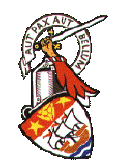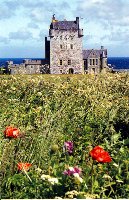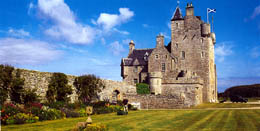The Feud Between
Clan Keith and Clan Gunn



Ackergill Tower in Caithness
From Darrell S. Keith's article, 'The Keiths and the Gunns', in the Clan Keith Society newsletter, 'Keith and Kin':
One of the most celebrated times in Clan Keith history occurred during the late 1400's. The event was the settling of a long and ongoing feud between the Keiths and the Gunns in Scotland's northern most territory of Caithness.


Map
of Scotland showing Caithness
Map of Caithness showing
Ackergill Tower
I will set the
stage for you and the rest will be the somewhat 'one-sided' account by the Gunns.
Reginald Cheyne was a large land owner in the Caithness area. He was the father
of only two daughters. Marjory and Mary. About the year 1340, Mary married John
Keith, second son of Edward Keith, Great Marischal of Scotland. Edward's home
was at Inverugie, near Peterhead, in Aberdeenshire. It was a very smart marriage
in that vast amounts of land in Caithness became in possession of the Keiths
through this marriage. Naturally, the Gunns, being long time residents of the
area, got very angry about the marriage and subsequent transfer of the Cheyne
lands to the Keiths.
The Gunns had been involved in a number of disputes
with several of their neighbors during the early 1400's. It is about this time
we pick up the story.
Lachlan Gunn was a small proprietor in Braemore. His
house is said to have been 'situated on the margin of a clear little stream
which issues from the northwest end of the Pap, one of the Braemore hills'. He
had an only daughter, Helen, who was far famed for her good looks and known as
'The Beauty of Braemore'. She was to be married to her cousin Alexander Gunn,
whom she had known since childhood, and the wedding date was fixed.
Dugald Keith of Ackergill, who at the time was acting
as factor for this property, saw Helen one day as he was passing through the
district and 'made a dishonourable proposal which was indignantly rejected'. He
decided to achieve his end by force, and on the eve of the wedding he set out
with a party of Keiths for Braemore where a number of relatives had gathered for
the festive occasion.
The Gunns were unprepared and taken by surprise, fighting followed with slaughter on both sides, but in the end the Gunns were overcome and the bride-to-be was seized and carried off to Ackergill tower where 'she became the victim of the brutal and licentious Keith'.
She determined on self destruction and
asked the keeper if she might see the country from the top of the tower. Knowing
she could not escape he granted this request and Helen ended her life by
throwing herself headlong from the battlements.

Ackergill Tower
The story continues...this excerpt
comes from the Clan Gunn website:
. . . it is clear that during the 14th and 15th centuries the Gunns were gradually dispossessed of their lands in the fertile parts of Caithness by the Sinclairs, Keiths and others, who obtained grants of land from the Scottish kings, anxious to increase their influence over the fringes of their kingdom. Consequently by the mid 15th century George Gunn of Ulbster, Chief of Clan Gunn and Crowner of Caithness, held his main lands at Ulbster and Clyth on the rocky coast of Caithness, and the majority fo the Clan by then occupied the highland regions of Caithness in what are now the Parishes of Latheron, Halkirk and Reay.
It was George Gunn, the Crowner, also known as 'Am Braisdeach Mor', or "Big Broochy' from the insignia worn by the Gunn Chiefs, as Crowners of Caithness, who after many skirmishes with the Clan Keith over rival land claims sought to reach a conciliation with the Keiths at St. Tayre's Chapel, near Ackergill Tower, the seat of Keith of Ackergill in 1478 (others say 1464) and was killed in the unequal battle at the chapel where the Keiths arrived for the twelve-aside parlay with two men to each horse. In 1978 the Earl of Kintore, Chief of Clan Keith and Iain Gunn of Banniskirk, the Commander of Clan Gunn, signed a Treaty of Friendship between the two clans at the site of the chapel, bringing to end the 500 year old feud.

Present day Ackergill Tower
Again continuing from Darrell S. Keith's article, 'The Keiths and the Gunns', in the Clan Keith Society newsletter:
We will once again pick up the story in the 1470's after much feuding had occurred over the alleged kidnapping of the so-called 'Beauty of Braemore' by the dashing Dugald Keith. It was during the 1470's that the Keiths and Gunns decided to end their long feuds once and for all. It goes like this. . .
About a half mile from Halberry Castle (a seat of the Gunns) stands Mannistanes Hill, so called for the many standing stones in the area, and the traditional site of a battle between the Keiths and the Gunns. Not infrequently in these family feuds when small numbers were involved the issue depended on the prowess of one warrior. This was the case at Mannistanes for the Keiths had a champion of outstanding size and strength known to history only as 'Caidh Mor', or 'The Big Keith', who wielded a two edged claymore and slew four or five of the picked men of the Gunns in succession. The battle was going the way of the Keiths when one of the wounded Gunns lying on the ground gave Caidh Mor a cut with his knife and divided the main tendon of one of his legs. The warrior was disabled and the dispirited Keiths withdrew from the field leaving the Gunns victorious though exhausted.
After recovering from his wounds the Big Keith left the country never to return.
There is a tradition that during the fight Big Keith was assisted by the devil in the shape of a large raven who perched on his shoulder and helped him by tearing out the eyes of some of the Gunns. However, the priest from Clyth Chapel who accompanied the Gunns 'knowing the character he had to deal with, administered some of his spiritual lotions' which completely neutralized the influence of his sable majesty.

Ackergill Tower - Now an Exclusive Resort Property
The information provided on this page comes from a variety of sources.
References are taken from: an article by Darrell S. Keith in the Clan Keith Society- U.S.A. newsletter, 'Keith and Kin'; wherein Mr. Keith references The History of Clan Gunn by Mark Rugg Gunn; from the Clan Gunn website; and from a reference on that site to The Clan Gunn and Its Country, published by the Clan Gunn Heritage Center, Latheron, Caithness.
Images on this page excerpted from the website: Ackergill Tower - An Exclusive Scottish Castle


